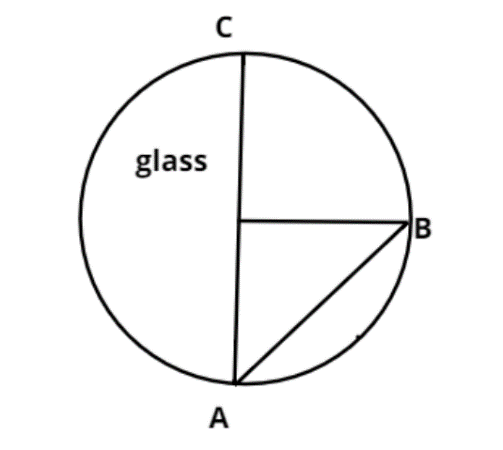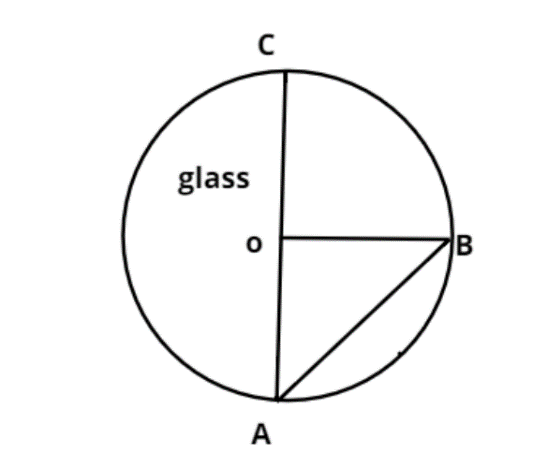
It is found that all electro-magnetic signals sent from A towards B reach point C inside the glass sphere, as shown in fig. The speed of the electromagnetic signals in glass cannot be

$
(a){\text{ 1}}{\text{.0}} \times {\text{1}}{{\text{0}}^8}m{s^{ - 1}} \\
(b){\text{ 2}}{\text{.4}} \times {\text{1}}{{\text{0}}^8}m{s^{ - 1}} \\
(c){\text{ 2}} \times {\text{1}}{{\text{0}}^7}m{s^{ - 1}} \\
(d){\text{ 4}} \times {\text{1}}{{\text{0}}^7}m{s^{ - 1}} \\
$

Answer
589.8k+ views
- Hint: In this question use the concept that in order for waves to travel from point A towards B to reach the point inside C the refractive index of the glass must be greater than the critical refractive index of the glass for total internal refraction that is $\mu > {\mu _{cric}}$. Use the concept that the speed (v) of the electromagnetic waves must be less than $\dfrac{C}{\mu }$ where C is the speed of the light, this will help approaching the problem.
Complete step-by-step solution -

As the electromagnetic signals travel inside the glass as shown in the figure from A to B and final to point C.
Thus the electromagnetic signals caused a total internal reflection inside the glass.
This is only possible if the refractive index of the glass must be greater than the critical refractive index of the glass for total internal refraction.
$ \Rightarrow \mu > {\mu _{cric}}$................ (1)
And hence the speed (v) of the electromagnetic waves must be less than the, $\dfrac{C}{\mu }$
$ \Rightarrow v < \dfrac{C}{\mu }$......... (2) so that the electromagnetic waves travel inside the sphere.
Where, C = speed of the sound in air = $3 \times {10^8}$m/s.
Now as we know ${\mu _{cric}} = \dfrac{1}{{\sin i}}$, where i = angle of incidence.
As we see from the figure O is the center of the circle and OA and OB are the radius of the circle.
So triangle AOB is an isosceles triangle (i.e. angles opposite to equal sides are equal).
Let $\angle OAB = \angle OBA = x$
And $\angle AOB = {90^o}$
As we know, a triangle sum of all the angles is 180 degrees.
$ \Rightarrow \angle AOB + \angle OAB + \angle OBA = {90^o} + x + x = {180^o}$
Now simplify this we have,
$ \Rightarrow x + x = {180^o} - {90^o} = {90^o}$
$ \Rightarrow 2x = {90^o}$
$ \Rightarrow x = \dfrac{{{{90}^o}}}{2} = {45^o}$
So the angle of incidence of the electromagnetic wave is $x = i = {45^o}$
$ \Rightarrow {\mu _{cric}} = \dfrac{1}{{\sin i}} = \dfrac{1}{{\sin {{45}^o}}} = \dfrac{1}{{\dfrac{1}{{\sqrt 2 }}}} = \sqrt 2 $
Now from equation (1) we have,
$ \Rightarrow \mu > \sqrt 2 $
Now from equation (2) we have,
$ \Rightarrow v < \dfrac{{3 \times {{10}^8}}}{{\sqrt 2 }}$
As, $\left[ {\because \sqrt 2 = 1.414} \right]$
$ \Rightarrow v < \dfrac{{3 \times {{10}^8}}}{{1.414}}$
\[ \Rightarrow v < 2.121 \times {10^8}\]m/s.
So the speed of the electromagnetic waves must be less than \[2.121 \times {10^8}\]m/s so that it travels inside the glass.
Hence from the given options option B cannot be possible.
So option (B) is the correct answer.
Note – In general refraction of the light wave moving from one medium into another medium does not happen at any angle, in fact there is a value of angle of incidence of the indenting light at the interface beyond which only the refraction can take place, so the largest angle of incidence above which we can see refraction is called as the critical angle for that incident light ray. This in case the trick was the incidence angle at which the incident beam of light is indenting upon the surface of the glass.
Complete step-by-step solution -

As the electromagnetic signals travel inside the glass as shown in the figure from A to B and final to point C.
Thus the electromagnetic signals caused a total internal reflection inside the glass.
This is only possible if the refractive index of the glass must be greater than the critical refractive index of the glass for total internal refraction.
$ \Rightarrow \mu > {\mu _{cric}}$................ (1)
And hence the speed (v) of the electromagnetic waves must be less than the, $\dfrac{C}{\mu }$
$ \Rightarrow v < \dfrac{C}{\mu }$......... (2) so that the electromagnetic waves travel inside the sphere.
Where, C = speed of the sound in air = $3 \times {10^8}$m/s.
Now as we know ${\mu _{cric}} = \dfrac{1}{{\sin i}}$, where i = angle of incidence.
As we see from the figure O is the center of the circle and OA and OB are the radius of the circle.
So triangle AOB is an isosceles triangle (i.e. angles opposite to equal sides are equal).
Let $\angle OAB = \angle OBA = x$
And $\angle AOB = {90^o}$
As we know, a triangle sum of all the angles is 180 degrees.
$ \Rightarrow \angle AOB + \angle OAB + \angle OBA = {90^o} + x + x = {180^o}$
Now simplify this we have,
$ \Rightarrow x + x = {180^o} - {90^o} = {90^o}$
$ \Rightarrow 2x = {90^o}$
$ \Rightarrow x = \dfrac{{{{90}^o}}}{2} = {45^o}$
So the angle of incidence of the electromagnetic wave is $x = i = {45^o}$
$ \Rightarrow {\mu _{cric}} = \dfrac{1}{{\sin i}} = \dfrac{1}{{\sin {{45}^o}}} = \dfrac{1}{{\dfrac{1}{{\sqrt 2 }}}} = \sqrt 2 $
Now from equation (1) we have,
$ \Rightarrow \mu > \sqrt 2 $
Now from equation (2) we have,
$ \Rightarrow v < \dfrac{{3 \times {{10}^8}}}{{\sqrt 2 }}$
As, $\left[ {\because \sqrt 2 = 1.414} \right]$
$ \Rightarrow v < \dfrac{{3 \times {{10}^8}}}{{1.414}}$
\[ \Rightarrow v < 2.121 \times {10^8}\]m/s.
So the speed of the electromagnetic waves must be less than \[2.121 \times {10^8}\]m/s so that it travels inside the glass.
Hence from the given options option B cannot be possible.
So option (B) is the correct answer.
Note – In general refraction of the light wave moving from one medium into another medium does not happen at any angle, in fact there is a value of angle of incidence of the indenting light at the interface beyond which only the refraction can take place, so the largest angle of incidence above which we can see refraction is called as the critical angle for that incident light ray. This in case the trick was the incidence angle at which the incident beam of light is indenting upon the surface of the glass.
Recently Updated Pages
Why are manures considered better than fertilizers class 11 biology CBSE

Find the coordinates of the midpoint of the line segment class 11 maths CBSE

Distinguish between static friction limiting friction class 11 physics CBSE

The Chairman of the constituent Assembly was A Jawaharlal class 11 social science CBSE

The first National Commission on Labour NCL submitted class 11 social science CBSE

Number of all subshell of n + l 7 is A 4 B 5 C 6 D class 11 chemistry CBSE

Trending doubts
What is meant by exothermic and endothermic reactions class 11 chemistry CBSE

10 examples of friction in our daily life

One Metric ton is equal to kg A 10000 B 1000 C 100 class 11 physics CBSE

1 Quintal is equal to a 110 kg b 10 kg c 100kg d 1000 class 11 physics CBSE

Difference Between Prokaryotic Cells and Eukaryotic Cells

What are Quantum numbers Explain the quantum number class 11 chemistry CBSE




